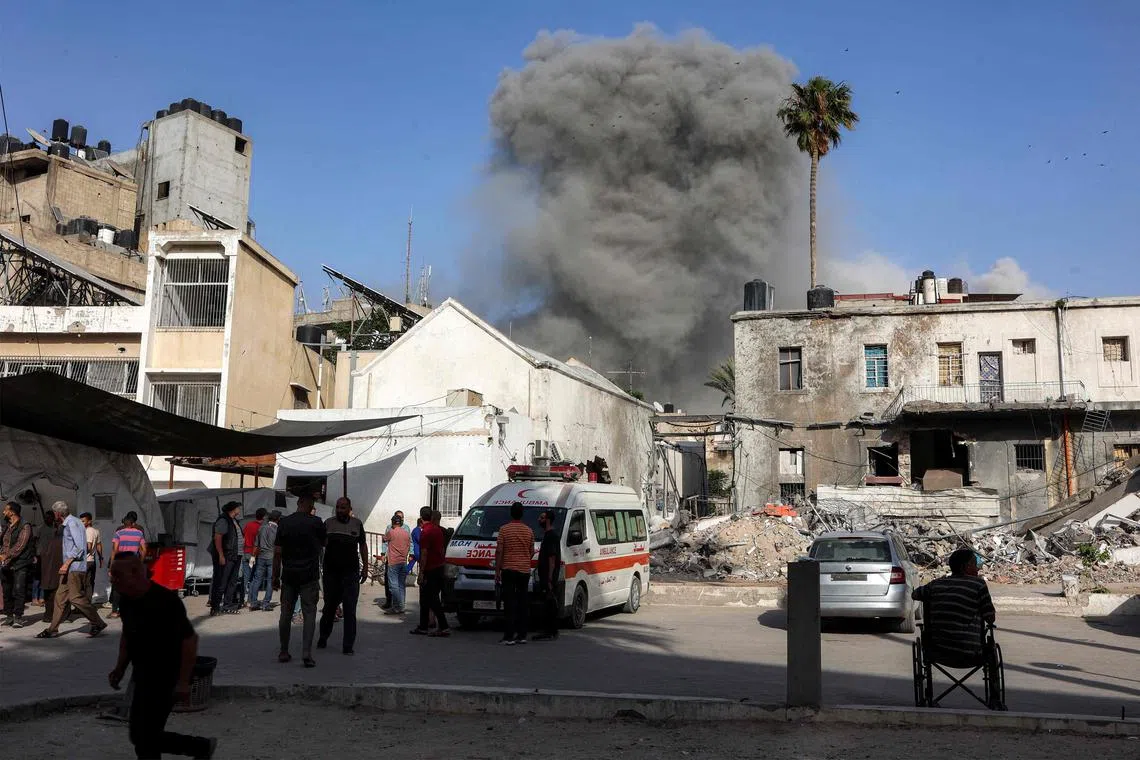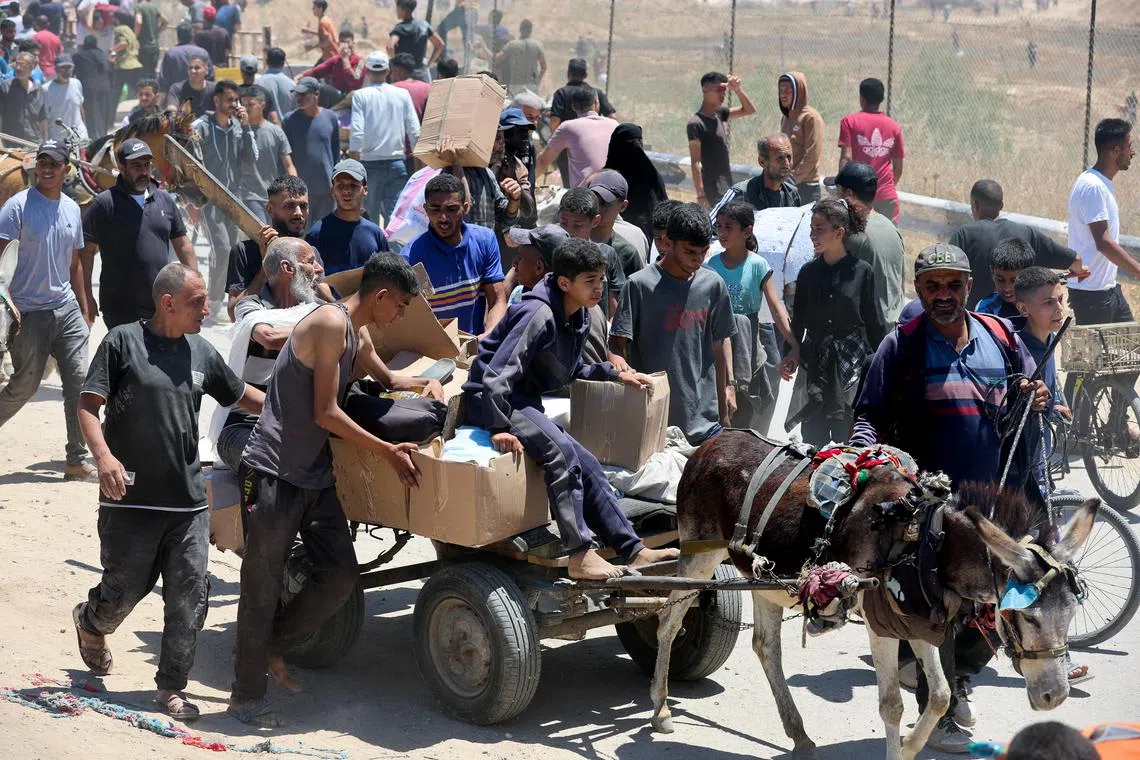Hamas seeks changes in US Gaza proposal; Witkoff calls response ‘unacceptable’
Sign up now: Get ST's newsletters delivered to your inbox

A Palestinian man inspecting the rubble following Israeli air strikes in Gaza City on May 31.
PHOTO: AFP
Follow topic:
CAIRO/JERUSALEM - Hamas said on May 31 it was seeking amendments to a US-backed proposal for a temporary ceasefire with Israel in Gaza, but US President Donald Trump’s envoy rejected the group’s response as “totally unacceptable”.
The Palestinian militant group said it was willing to release 10 living hostages and hand over the bodies of 18 dead in exchange for Palestinian prisoners in Israeli prisons.
But Hamas reiterated demands for an end to the war and the withdrawal of Israeli troops from Gaza – conditions Israel has rejected.
A Hamas official described the group’s response to the proposals from Mr Trump’s special Middle East envoy, Mr Steve Witkoff, as “positive” but said it was seeking some amendments.
The official did not elaborate on the changes being sought by the group.
Israeli Prime Minister Benjamin Netanyahu said that while his government had agreed to Mr Witkoff’s outline, Hamas was continuing its rejection of the plan.
“Israel will continue its action for the return of our hostages and the defeat of Hamas,” he said in a statement.
Earlier on May 31, Hamas issued a statement saying: “This response aims to achieve a permanent ceasefire, a complete withdrawal from the Gaza Strip, and to ensure the flow of humanitarian aid to our people in the Strip.”
The document containing Hamas’ response, seen by Reuters, demands that Gaza residents be allowed unrestricted travel through the Rafah crossing and that the movement of goods be resumed.
It calls for restoring Gaza’s infrastructure, including electricity, water and sanitation, and seeks permission for building materials needed to repair hospitals, health centres, schools, and bakeries across the Strip.
Under the Hamas plan, which the document says is guaranteed by Mr Trump and mediators Egypt and Qatar, Israel would stop all military activity in Gaza when the ceasefire agreement goes into effect, and aid would be delivered by the United Nations, the Red Crescent and other agreed channels.
The Palestinian group said it would provide information about the number of living and deceased Israeli hostages held in Gaza in exchange for details about Palestinian prisoners detained since Hamas attacked on Oct 7, 2023.
“President Trump will personally announce the ceasefire agreement. The US and President Trump are committed to ensuring serious negotiations until a final agreement is reached,” the document says.
The proposals envisage a 60-day truce and the exchange of 28 of the 58 hostages still held in Gaza for more than 1,200 Palestinian prisoners and detainees, along with the entry of humanitarian aid into the enclave.
Senior Hamas official Basem Naim denied any rejection of Mr Witkoff’s proposal but said Israel’s response was incompatible with what had been agreed, and accused the US envoy of acting with “complete bias” in favour of Israel.
A Palestinian official familiar with the talks told Reuters that among the amendments Hamas is seeking is the release of the hostages in three phases over the 60-day truce and more aid distribution in different areas.
Hamas also wants guarantees the deal will lead to a permanent ceasefire, the official said.
Israel has previously rejected Hamas’ conditions, instead demanding the complete disarmament of the group and its dismantling as a military and governing force, along with the return of all 58 remaining hostages.
Mr Trump said on May 30 he believed a ceasefire agreement was close after the latest proposals, and the White House said on May 29 that Israel had agreed to the terms.
Saying he had received Hamas’ response, Mr Witkoff wrote in a post on X: “It is totally unacceptable and only takes us backward. Hamas should accept the framework proposal we put forward as the basis for proximity talks, which we can begin immediately this coming week.”
On May 31, the Israeli military said it had killed Mohammad Sinwar,
Sinwar, the younger brother of Yahya Sinwar, the group’s deceased leader and mastermind of the October 2023 attack on Israel, was the target of an Israeli strike on a hospital in southern Gaza.
Hamas has neither confirmed nor denied his death.

A cloud of smoke billowing from Israeli air strikes near a hospital in Gaza City on May 31.
PHOTO: AFP
The Israeli military, which relaunched its air and ground campaign in March
The campaign has cleared large areas
Israel imposed a blockade on all supplies entering the enclave
On May 31, aid groups said dozens of World Food Programme (WFP) trucks carrying flour to Gaza bakeries had been hijacked by armed groups and subsequently looted by people desperate for food
“After nearly 80 days of a total blockade, communities are starving and they are no longer willing to watch food pass them by,” the WFP said in a statement.
‘A mockery’
The United Nations said on May 30 the situation in Gaza is the worst since the start of the war 19 months ago, with the entire population facing the risk of famine despite a resumption of limited aid deliveries earlier in May.
“The aid that’s being sent now makes a mockery of the mass tragedy unfolding under our watch,” Mr Philippe Lazzarini, head of the main UN relief organisation for Palestinians, said in a message on X.
Israel has been allowing a limited number of trucks from the WFP and other international groups to bring flour to bakeries in Gaza but deliveries have been hampered by repeated incidents of looting.

Palestinians carrying away aid supplies received from the US-backed Gaza Humanitarian Foundation on May 29, near an area of Gaza known as the Netzarim corridor.
PHOTO: REUTERS
A separate system, run by a US-backed group called the Gaza Humanitarian Foundation (GHF), has been delivering meals and food packages at three designated distribution sites.
However, aid groups have refused to cooperate with the GHF, which they say is not neutral, and say the amount of aid allowed in falls far short of the needs of a population at risk of famine.
Israel denies operating a policy of starvation and says it is facilitating aid deliveries, pointing to its endorsement of the new GHF distribution centres and its consent for other aid trucks to enter Gaza.
Instead, it accuses Hamas of stealing supplies intended for civilians and using them to entrench its hold on Gaza, which it had been running since 2007.
Hamas denies looting supplies and has executed a number of suspected looters.
Israel began its campaign in Gaza in response to the Hamas-led attack on communities in southern Israel
The campaign has laid waste large areas of the Gaza Strip, killing more than 54,000 Palestinians and destroying or damaging most of its buildings, leaving most of the population in makeshift shelters. REUTERS

